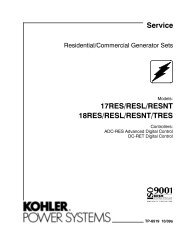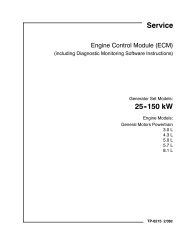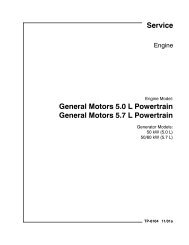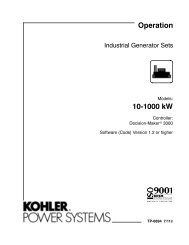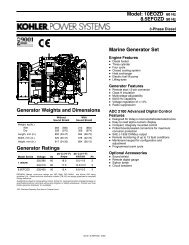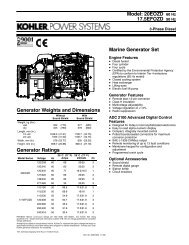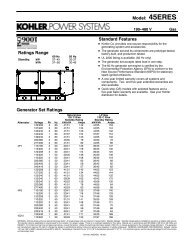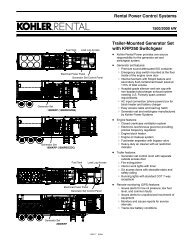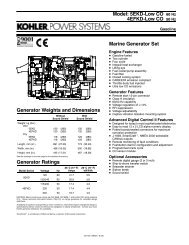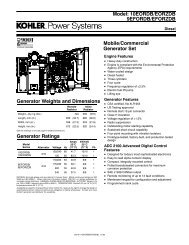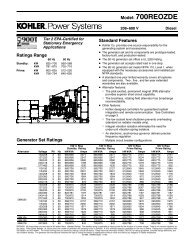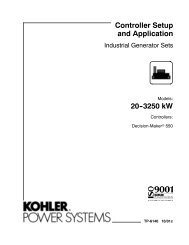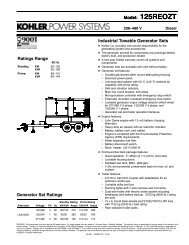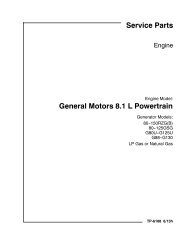Service Manual, General Motors 4.3L Engine (TP ... - Kohler Power
Service Manual, General Motors 4.3L Engine (TP ... - Kohler Power
Service Manual, General Motors 4.3L Engine (TP ... - Kohler Power
Create successful ePaper yourself
Turn your PDF publications into a flip-book with our unique Google optimized e-Paper software.
<strong>Engine</strong> Marine/Industrial <strong>4.3L</strong> 6-177<br />
clamping properly or cause damage when the fastener is<br />
tightened.<br />
The surfaces to be sealed must be clean and dry.<br />
• Use a RTV sealant bead size as specified in the service<br />
procedure.<br />
• Apply the RTV sealant bead to the inside of any bolt hole<br />
areas.<br />
• Assemble the components while the RTV sealant is still wet<br />
to the touch (within 3 minutes). Do not wait for the RTV<br />
sealant to skin over.<br />
• Tighten the fasteners in sequence (if specified) and to the<br />
proper torque specifications. DO NOT overtighten the<br />
fasteners.<br />
Anaerobic Type Gasket Eliminator Sealant<br />
Anaerobic type gasket eliminator sealant cures in the absence of<br />
air. This type of sealant is used where 2 rigid parts (such as<br />
castings) are assembled together. When 2 rigid parts are<br />
disassembled and no sealant or gasket is readily noticeable, then<br />
the 2 parts were probably assembled using an anaerobic type<br />
gasket eliminator sealant.<br />
Use the following information when using gasket eliminator<br />
sealant:<br />
• Always follow all the safety recommendations and directions<br />
that are on the gasket eliminator sealant container.<br />
• Apply a continuous bead of gasket eliminator sealant to one<br />
flange.<br />
The surfaces to be sealed must be clean and dry.<br />
Important: Do not allow the gasket eliminator sealant to enter any<br />
blind threaded holes, as the gasket eliminator sealant may prevent<br />
the fasteners from clamping properly, seating properly or cause<br />
damage when the fastener is tightened.<br />
Apply the gasket eliminator sealant evenly to get a uniform<br />
thickness of the gasket eliminator sealant on the sealing surface.<br />
Important: Gasket eliminator sealed joint fasteners that are<br />
partially torqued and the gasket eliminator sealant allowed to cure<br />
more than 5 minutes, may result in incorrect shimming and sealing<br />
of the joint.<br />
• Tighten the fasteners in sequence (if specified) and to the<br />
proper torque specifications. DO NOT overtighten the<br />
fasteners.<br />
• After properly tightening the fasteners, remove the excess<br />
gasket eliminator sealant from the outside of the joint.<br />
Anaerobic Type Threadlock Sealant<br />
Anaerobic type threadlock sealant cures in the absence of air. This<br />
type of sealant is used for threadlocking and sealing of bolts,<br />
fittings, nuts and studs. This type of sealant cures only when<br />
confined between 2 close fitting metal surfaces.<br />
Use the following information when using threadlock sealant:<br />
• Always follow all safety recommendations and directions<br />
that are on the threadlock sealant container.<br />
• The threaded surfaces must be clean and dry.<br />
• Apply the threadlock sealant as specified on the<br />
threadlock sealant container.<br />
Important: Fasteners that are partially torqued and<br />
then the threadlock sealant allowed to cure more than<br />
five minutes, may result in incorrect clamp load of<br />
assembled components.<br />
Tighten the fastener in sequence (if specified) and to<br />
the proper torque specification. DO NOT overtighten<br />
the fasteners.<br />
Anaerobic Type Pipe Sealant<br />
Anaerobic type pipe sealant cures in the absence of air<br />
and remains pliable when cured. This type of sealant is<br />
used where 2 parts are assembled together and<br />
require a leak proof joint.<br />
Use the following information when using pipe sealant:<br />
• Do not use pipe sealant in areas where extreme<br />
temperatures are expected. These areas<br />
include:<br />
– The exhaust manifold<br />
– The head gasket<br />
– Surfaces where a different sealant is specified<br />
• Always follow all the safety recommendations<br />
and directions that are on the pipe sealant<br />
container.<br />
• Ther surfaces to be sealed must be clean and<br />
dry.<br />
• Use a pipe sealant bead of the size or quantity<br />
as specified in the service procedure.<br />
Important: Do not allow the pipe sealant to enter any<br />
of the blind threaded holes, as the pipe sealant may<br />
prevent the fastener from clamping properly, or cause<br />
component damage when the fastener is tightened.<br />
• Apply the pipe sealant bead to the inside of any<br />
bolt hole areas.<br />
• Apply a continuous bead of pipe sealant to 1<br />
sealing surface.<br />
• Tighten the fasteners in sequence (if specified)<br />
and to the proper torque specifications. DO NOT<br />
overtighten the fasteners.<br />
Separating Parts<br />
Important: Many internal engine components will<br />
develop specific wear patterns on their friction<br />
surfaces.<br />
When disassembling the engine, internal components<br />
MUST be seperated, marked and organized in a way<br />
to ensure reinstallation to the original location and<br />
position.<br />
Mark or identify the following components:<br />
2000 Marine/Industrial



